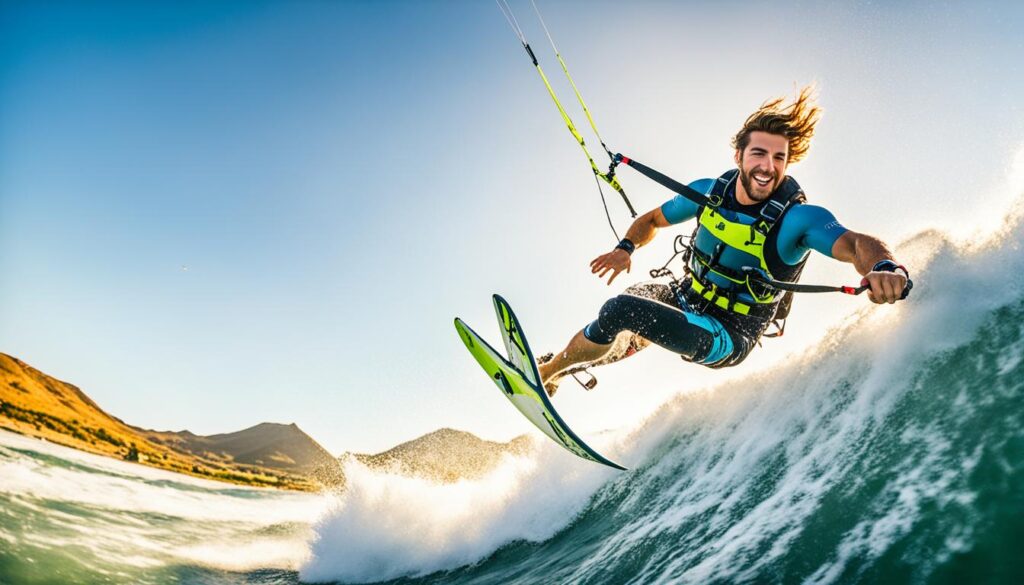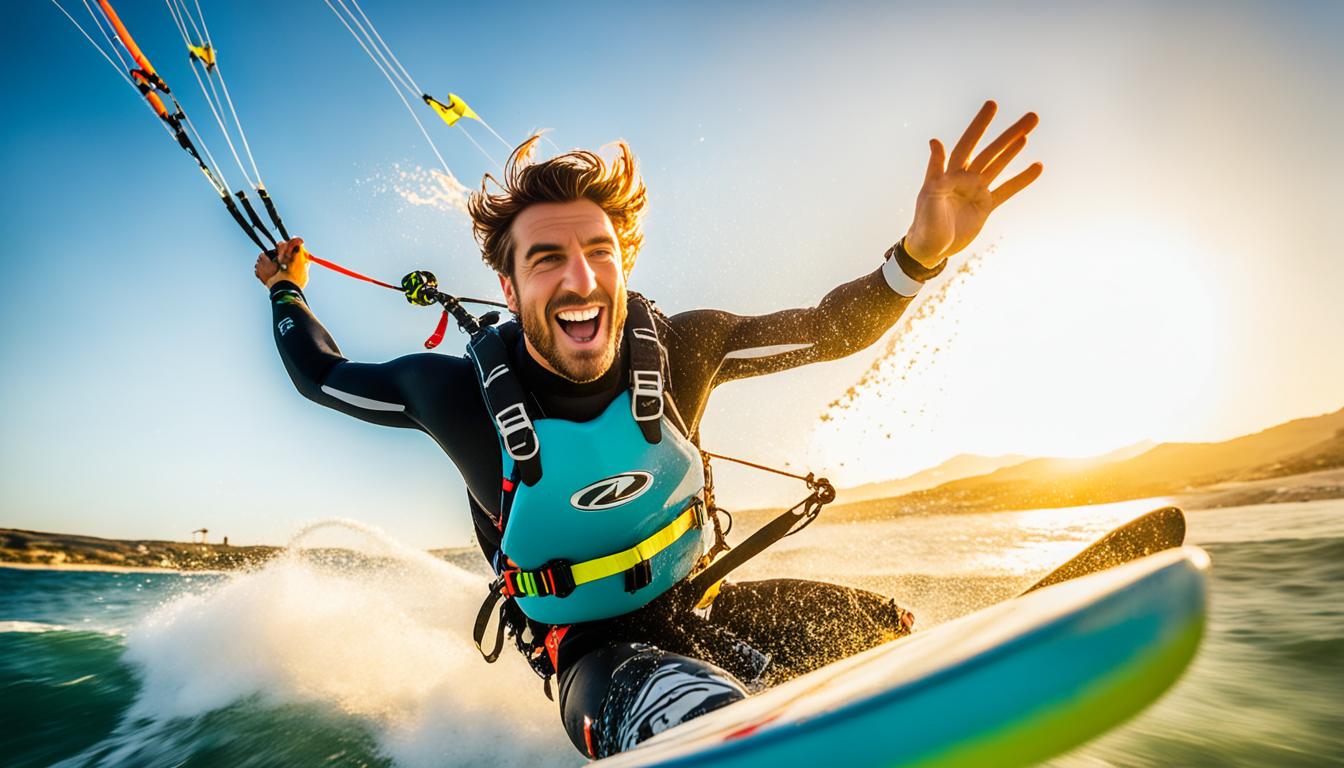Kitesurfing is more than a sport; it’s a way of life for those who love the ocean and seek thrills. It’s done on beautiful waters all over the world. Many wonder, “Is it hard to learn kitesurfing?” For those who love watching kites dance in the sky, wanting to master kitesurfing is a big dream. But, the thought of the kitesurfing difficulty stops some people.
This kitesurfing guide will help you through the ups and downs of learning. We’ll give you beginner kitesurfing tips to help you start and grow. This article is your guide to the exciting world of kitesurfing. If you’re just starting or want to get better, get ready to learn about this fun sport. You’ll find out how to make it your own and start an exciting journey.
Understanding the Basics of Kitesurfing
Starting with kitesurfing means learning the kiteboarding basics. You need to know about the kitesurfing equipment you’ll use. This includes kites, boards, and a harness that keeps you connected to the kite. These tools are key to moving across the water.
Learning about wind theory is vital for kitesurfing fundamentals. It helps you control your moves and stay safe. Knowing how to use the wind can make your rides better and safer.
Safety is a big part of water sport essentials. Always check your gear and know the weather before you go. Taking lessons can help you get better at kite handling. This makes kitesurfing more fun and safe.
The Learning Curve for Beginners
Learning kitesurfing is exciting and tough. If you’re thinking about starting kitesurfing, know what to expect. This part talks about the first steps in kitesurfing practice. It helps newbies see what they’ll go through at first.
When you start learning kitesurfing, getting good at kite control is key. You’ll spend many sessions on the beach learning to handle the kite. This is important to build your skills and confidence for riding the water.
Kitesurfing schools suggest a 5 to 10 lesson plan, lasting weeks. This depends on how fast you pick up the sport and the weather. You’ll learn about safety, weather, and how to use your gear.
One big challenge is dealing with changing winds. This can make learning take longer. But, it also means you get to practice in different conditions. The way you learn can change how fast you get better. Getting one-on-one lessons can help you learn faster than group classes.
New kitesurfers love their first ride on their own. Instructors say to be patient and keep practicing. Everyone learns at their own pace, but the fun of mastering kitesurfing is the same for all.
Starting kitesurfing practice is the first step on an exciting journey. With good teaching, hard work, and respect for nature, the tough start becomes easier. Soon, you’ll enjoy the rewards of being on the water.
Progressing from Beginner to Intermediate
Moving from a beginner to an intermediate kitesurfer is a big step. At this level, you start learning new moves. These moves need a good understanding and control of the kite and board.
One key skill is turning smoothly from one direction to another without losing speed. This is important for kitesurfing.
Intermediate kitesurfing also means learning to ride upwind. This lets riders move against the wind. It makes it easier to move around and try new things.
As you get better, you’ll start doing basic jumps. This makes kitesurfing more fun.
Getting better at kiteboarding means working on your body position and controlling the board. These skills make it safer and more fun in tough conditions.
Experts say it’s important to practice a lot and be patient. They recommend setting small goals to help you improve. This way, you can move from beginner to intermediate skills step by step.

Advanced Kitesurfing Techniques
When you move from being an intermediate to a advanced kitesurfer, you enter a world of exciting techniques and kitesurfing tricks. It’s not just about skill. It’s also about knowing the wind and water well. Let’s explore the exciting world of advanced moves in professional kiteboarding.
Wave riding is a big goal for many in competitive kitesurfing. It’s different from surfing because you control the kite and the board at the same time. This needs a lot of practice and help from experts who know a lot.
Advanced kitesurfers do cool jumps and tricks like the Kite Loop, Board Offs, and Handle Passes. These kitesurfing tricks show how good you are at being quick and in control. If you want to get this good, going to special clinics or camps for advanced kitesurfing is a great idea.
To learn advanced techniques, you need to know a lot about your gear and the weather. The right kite, board, and harness can really help you perform better. Also, knowing when the weather is right for trying new tricks is key. It can make a big difference between doing a trick well or not.

Getting to an advanced level in kitesurfing takes hard work, love, and lots of practice. It’s about doing new things on the water and always trying to get better. Whether you want to compete or just improve your skills, the advanced moves of kiteboarding are exciting and rewarding.
Comparing Kitesurfing to Other Water Sports
Kitesurfing, windsurfing, and surfing are all extreme water sports. They have their own unique challenges and thrills. Kitesurfing is different from surfing in many ways.
Surfing needs you to know how waves work and how to move fast and balance. Kitesurfing mixes surfing and flying to create a new sport. It requires skills in both water and air.
Kitesurfing and windsurfing both use wind to move. But they are not the same. Windsurfing uses a fixed sail on a board. It’s easier for beginners than kitesurfing, which is more complex.
Learning one sport can help with another. Skills from surfing can help with kitesurfing or windsurfing. Knowing about wind helps with kitesurfing.
Kitesurfing is special because it needs both physical skill and understanding the environment. Moving from one sport to another can be easier with the right skills. Balance, wind knowledge, and board control help with all these sports.
Conclusion
Kitesurfing is a journey full of challenges but also lots of fun. It’s a mix of working out, thinking hard, and feeling the wind. If you want to try kitesurfing, be ready to learn and grow.
Going from a beginner to a pro takes time and effort. You need to practice a lot, know how to stay safe, and learn from experts. The best part is feeling the sea spray and flying through the air. Keep trying and don’t give up.
This summary shows how important it is to work hard and listen to those who know. If you’re thinking about starting with kitesurfing, this article is here to help you. Get ready to feel the wind and enjoy the sea. With patience and hard work, you can master kitesurfing.
